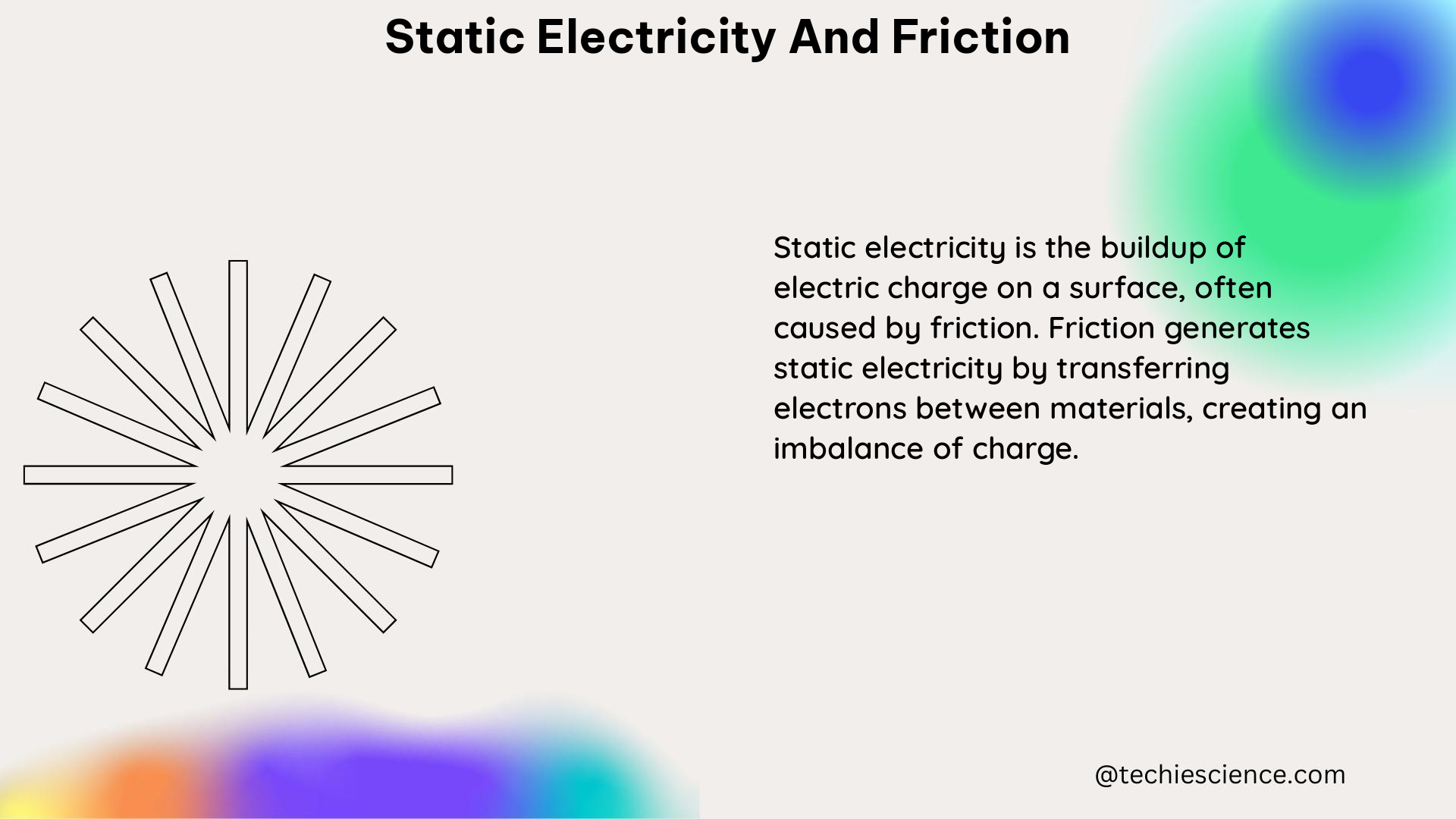Static electricity is a fascinating phenomenon that arises due to the buildup of electrical charges on the surface of materials. This charge imbalance can create an electric field, which can influence the behavior of other charged objects nearby. Friction is one of the primary mechanisms that can cause static electricity, as the rubbing of two materials can lead to the transfer of electrons from one material to another.
Understanding Static Electricity
Static electricity is the result of an imbalance of electric charges within or on the surface of a material. This imbalance can be caused by a variety of factors, including friction, contact with other materials, and changes in temperature or humidity.
Coulomb’s Law and Electric Fields
The behavior of static electricity is governed by Coulomb’s law, which states that the force between two charged particles is directly proportional to the product of their charges and inversely proportional to the square of the distance between them. This relationship is expressed by the equation:
F = k * (q1 * q2) / r^2
where F is the force, k is the Coulomb constant, q1 and q2 are the charges of the two particles, and r is the distance between them.
The electric field is a region of space in which electrical forces act, and it is influenced by the presence of charged objects. The electric field lines run perpendicular to the charged material and show the direction in which the force acts. The electric field can be coupled with other bodies, which can have important consequences for measuring and neutralizing the charge.
Gauss’s Theorem and Electric Flux
Gauss’s theorem, also known as Gauss’s law, is another important principle in understanding static electricity. This theorem states that the total electric flux out of a closed surface is equal to the charge enclosed divided by the permittivity of space. This relationship is expressed by the equation:
Φ = Q_enc / ε0
where Φ is the electric flux, Q_enc is the charge enclosed, and ε0 is the permittivity of free space.
Measuring Static Electricity
Measuring static electricity is crucial for understanding its behavior and ensuring the safe operation of equipment and systems that are susceptible to it. One common method for measuring static electricity is to use a static meter, such as the Fraser 715 Static Meter, which uses a capacitor-based circuit to measure the voltage across a capacitor that is charged in proportion to the static charge on the material.
The relationship between the field strength and voltage of a static charge is described by the equation Q = CmV, where Q is the charge, Cm is the capacitance, and V is the voltage. This equation shows that the charge Q varies directly with the voltage V, meaning that a higher voltage corresponds to a larger charge.
Factors Influencing Static Electricity

In addition to friction, there are several other factors that can influence the generation of static electricity.
Climate Conditions
The climate conditions of a laboratory can affect weighing results by influencing the electrostatic charge of samples. Relative humidity levels less than 40 to 50% can increase electrostatic charge issues, while charges on materials can cause weights to drift several hundred milligrams in dry atmospheres with less than 20% relative humidity.
Liquid Conductivity
To combat electrostatic ignition hazards, it is important to measure the conductivity of liquids, as low conductivity liquids can generate hazardous levels of static electricity during motion. The Fraser L40 Liquid Conductivity Meter, for example, can measure electrical conductivity to below 1 pS.m-1, which is essential for determining ignition hazards.
Examples of Static Electricity and Friction
There are several everyday examples of static electricity and friction in action:
- The attraction of a comb to hair after running it through the hair repeatedly.
- The spark generated when touching a metal doorknob after walking across a carpeted room.
Numerical Problems
- Coulomb’s Law: Calculate the force between two charged particles with charges of +3 μC and -5 μC, respectively, and a separation distance of 0.1 m.
F = k * (q1 * q2) / r^2
F = 8.99 × 10^9 * (3 × 10^-6 * -5 × 10^-6) / (0.1)^2
F = -2.697 × 10^-3 N
- Gauss’s Theorem: Determine the electric flux through a spherical surface with a radius of 0.5 m and a charge of +10 μC enclosed inside.
Φ = Q_enc / ε0
Φ = (10 × 10^-6 C) / (8.854 × 10^-12 F/m)
Φ = 1.13 × 10^6 N·m^2/C
Key Figures, Data Points, and Measurements
- The voltage across a capacitor varies directly with the charge, as described by the equation
Q = CmV. - Relative humidity levels less than 40 to 50% can increase electrostatic charge issues.
- Low conductivity liquids can generate hazardous levels of static electricity during motion.
References
- Measurement of Static Electricity – Fraser Anti-Static Techniques
- Fact or Friction: Your Balance Static Questions Answered – Fishersci.com
- Static electricity: quantitative measurement & prevention – VEX Forum
Hi, I’m Akshita Mapari. I have done M.Sc. in Physics. I have worked on projects like Numerical modeling of winds and waves during cyclone, Physics of toys and mechanized thrill machines in amusement park based on Classical Mechanics. I have pursued a course on Arduino and have accomplished some mini projects on Arduino UNO. I always like to explore new zones in the field of science. I personally believe that learning is more enthusiastic when learnt with creativity. Apart from this, I like to read, travel, strumming on guitar, identifying rocks and strata, photography and playing chess.